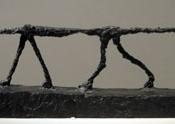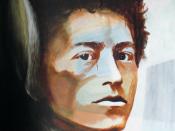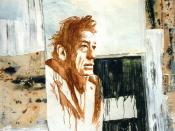Man Pointing" is a life size bronze sculpture by Italian artist Alberto Giacometti (from the arguably Surrealist, or Expressionist periods). The sculpture reveals Giacometti's interpretations of his own sense of naturalism and investigation of the human form. The artist developed a unique, stylized handling of surface, and form as a vehicle for expression.
Alberto Giacometti was born October 1901 into an artistic family in a Swiss town near the Italian border. He settled in Paris in 1922, studying painting. printmaking and sculpture with Antoine Bourdelle an associate of Auguste Rodin. There he first became associated with the Cubists. Later he became instrumental in the development of Surrealism. Around 1935 Giacometti moved away from Surrealist imagery and began creating elongated and emaciated figure sculptures. For a time he created these sculptures on a small scale, but is better known for his larger life size pieces. These works, usually in bronze, are considered his most remarkable and mature work.
Figure 1-Alberto Giacometti "Man Pointing" 1947"Man Pointing" (Fig. 1) is a vertically oriented male figure that stands alone with an outstretched arm and pointing finger. It is roughly the height of an average man, including its thick rectangular base. The figure is extremely elongated with thin, simplified limbs, torso, and pelvis. The surface of the bronze is textural, and jagged, as if it has been chewed or grinded. The base, which anchors the figure, also provides a stepping off point. The head and facial features, like the body, are distorted and elongated into oval shapes which create shadows adding to its depth.
"Man Pointing" transforms the space it inhabits. There is a tension in the figure's body and although it is emaciated and skeletal it possesses solidity in strength and stature. The lines of the legs pull the eye upwards to...


